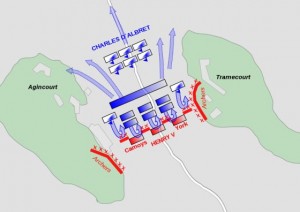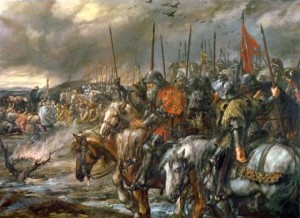Today is the 600th Anniversary of the Battle of Agincourt, in which the heavily outnumbered, archer-heavy English led by Henry V defeated an army of French knights.
Yet it likely wasn’t the arrow storm that defeated the French, says Bernard Cornwell in a terrific article in The Telegraph.
Legend says Agincourt was won by arrows. It was not. It was won by men using lead-weighted hammers, poleaxes, mauls and falcon-beaks, the ghastly paraphernalia of medieval hand-to-hand fighting. It was fought on a field knee-deep in mud, and it was more of a massacre than a battle. Olivier’s famous film shows French knights charging on horseback, but very few men were mounted.
Cornwell notes that the English archers could have unleashed an arrowstorm consisting of a thousand arrows a second. Even if you cut that rate by a third, it still is a blistering rate. And yet, Cornwell notes, French advances in armor saved the bulk of the French knights from becoming pincushions:
So the many reached the few, but the many were exhausted by mud, some were wounded and the English, enjoying the luxury of raised visors, cut them down. What seems to have happened was that the front rank of the French, exhausted by slogging through the mud, battered and wounded by arrows, disorganised by panicked horses and by stumbling over wounded men, became easy victims for the English men-at-arms.
At the end, Cornwell addresses the question of why a battle that had such little immediate tactical or strategic value still stirs the blood. Was it Shakespeare? No, Cornwell argues, Shakespeare wrote about Agincourt because it already was legend. Rather:
The battle of Agincourt is part of the binding of England, the emergence of the common man as a vital part of the nation. Those common men returned to England with their stories and their pride, and these stories were told in taverns over and over, how a few hungry trapped men had gained an amazing victory. The story is still remembered, even six hundred years later, because it has such power. It is a tale of the common man achieving greatness. It is an English tale for the ages, an inspiration and we can be proud of it.
Read the article. I think you’ll find it interesting, even if you — as am I — are well versed in the details of the battle.



